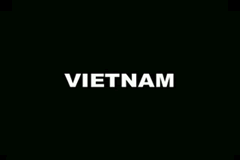 |
|
| The History of America at War - Focus: Vietnam | ||||||||
The conflict's roots took shape in July 1954, when France was forced out of Vietnam after one hundred years of colonial rule. In the peace process, the country was partitioned into northern and southern sections, with a U.S.-supported government in the south and a Communist supported republic in the north. On December 20, 1960, the northern Communist Party formed the National Liberation Front (NLF), with the ultimate goal of reunifying the country. In response, U.S. President John F. Kennedy began supplying military equipment and advisors in 1961. The Geneva Peace Accords, signed by France and Viet Nam in the
summer of 1954, reflected the strains of the international Cold
War. Because of outside pressures brought to bear by the Soviet
Union and the People's Republic of China, Vietnam's delegates to
the Geneva conference agreed to the temporary partition of their
nation at the seventeenth parallel. The Communist superpowers feared
that a provocative peace would anger France and its powerful ally,
the United States. Moscow and Peking did not want to risk another
confrontation with the West so soon after Korea. Furthermore, the
Communists believed they were better organized to take southern
Vietnam by political action alone, a prediction that did not come
to pass. At the time of the Kennedy and Diem assassinations, there were 16,000 American military advisers in Vietnam. The Kennedy administration had managed to run the war from Washington without the large-scale introduction of combat troops. The continuing political problems in Saigon, however, convinced the new president, Lyndon B. Johnson, that more aggressive action was needed. In any event, after suspected Communist attacks on two U.S. ships in the Gulf of Tonkin, the Johnson administration argued for expansive war powers for the president. Ultimately, lacking a credible plan for winning the war, the American government was forced to give in to the wishes of the American people and withdraw its troops from Vietnam. In early January 1973, the Nixon administration, the Paris Peace Agreement ended open hostilities between the U.S. and North Vietnam. However, the South Vietnamese continued to battle the Communists from March 1973 until the fall of Saigon and the capture of the South Vietnamese presidential palace on April 30, 1975. Communist forces captured the presidential palace in Saigon, ending the Second Indochina War. So divisive was the conflict in Vietnam and America's involvement
that relations among the government, the people and the military
would be strained until they were reunified by the Gulf War 25 years
later. As evidenced by numerous documentaries, books and films about
the war, the hard lessons the U.S. learned in Vietnam are still
very much in the public consciousness. |
||||||||
This website designed, constructed, programmed, and powered by 4D Solutions, Inc.
